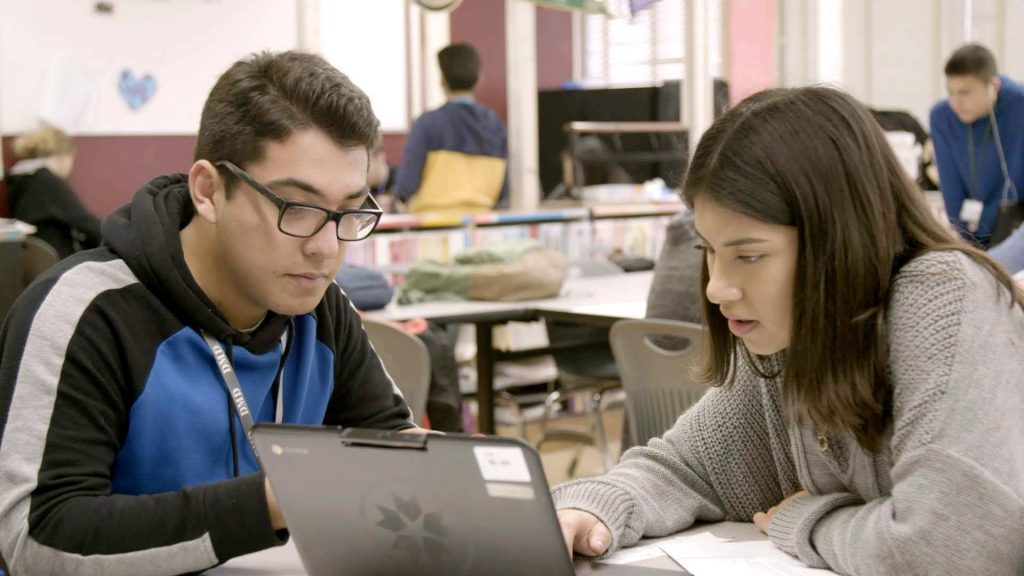Introduction
Learn how one school district is using California’s Local Control Funding Formula (LCFF) to bolster teachers’ professional learning to drive more equitable outcomes for its students.
Over the last several years, Pomona Unified School District (PUSD) has offered teachers more voice and choice in professional development and created an array of teacher leader roles to address the academic and social emotional learning needs of its 24,000 students, of which the majority are historically underserved (i.e., low-income students, foster youth, English Learners).
PUSD has supported a variety of teacher leader roles, including a co-teaching model in several schools, to spread teaching expertise for implementation of the state’s standards and Positive Behavior Interventions and Supports (PBIS). The paper points to how the district’s efforts have fueled teachers’ efficacy and a promising way forward for improving student achievement across school sites. The authors’ policy paper also points to what districts can do to accelerate these results by (1) better understanding school readiness for teacher-led learning and leadership, (2) systematically spreading teaching expertise across the district, and (3) building the capacity of the central office to cultivate more formal and informal opportunities for classroom practitioners to lead without leaving the classroom. The authors expand upon Pomona’s current efforts with practice and policy recommendations to help spread new teacher-led change strategies across the state.
Key Findings
- Teacher-led PBIS training is yielding positive results in terms of school climate and student academic achievement. In 2017–2018, of the 20 schools that substantially increased student achievement in English Language Arts (ELA), 17 were PBIS sites. And of the 15 schools that improved their Mathematics performance, 12 were PBIS sites as well.
- Four years after pilot schools began PBIS implementation, the number of Office Discipline Referrals across PBIS schools has decreased by 48 percent and suspensions have decreased by 61 percent.
- Student achievement is comparatively higher in co-teaching classrooms. For example, 64 percent of their students scored a 3 or 4 in Mathematics and English Language Arts (ELA), although the entire class they taught entered as 1s or 2s on the California Dashboard from the previous year.
Pomona USD Video Interview Series

School Districts
1. Gather more detailed data on what teachers want and need to be successful. Districts must take inventory of the efficacy of current professional learning strategies to design a system that accelerates outcomes.
2. Identify exemplar professional learning schools and turn them into learning labs. Districts should highlight models of quality professional learning and invest in them.
3. Determine the underlying factors that get in the way of teachers spreading their expertise. Each school operates in a different context and should engage in a learning process that is tailor-made for its unique environment.
4. Cultivate administrators who have the ability to foster strong teacher collaboration and quality instruction. At PUSD, teacher collaboration is most effective when administrators understand how to best support their teaching talent and spread educator expertise systematically.

State
1. Support statewide, annual surveys about professional learning experiences to guide improvement. The ambitious goals of LCFF and a statewide system of support require exceptional coordination among educators, school sites, districts, and counties. A stronger and more frequent exchange of ideas from local educators and state decision makers is needed.
2. Elevate promising models of teacher-led learning across the state under the statewide system of support. Highlighting more examples of implementation strategies of teacher-led learning models like those emerging in PUSD could help improve the efficacy of the system of support and also ensure its sustainability for professional learning is not dependent on the expertise of outside entities.
3. Pursue ideas of shared leadership and teacher-led learning in the California Administrator Performance Expectations (CAPE) and California Teaching Performance Expectations (CTPE) that identify a variety of roles for expert educators who can serve in more hybrid roles of leadership. The California Commission on Teacher Credentialing should explore innovative ways to recognize teachers who lead without leaving the classroom and to recognize administrators who can experiment with new models of leadership.
4. Expand California’s Instructional Leadership Corps (ILC) with a virtual learning community component. This “teachers teaching teachers” model trains teacher leaders to facilitate ongoing professional learning around the state’s new Mathematics, science, and English Language Arts (ELA) standards within their own districts. A virtual learning component could assist districts like Pomona to spread teaching expertise and serve a variety of professional learning needs of teachers and their students.”
Related Work






